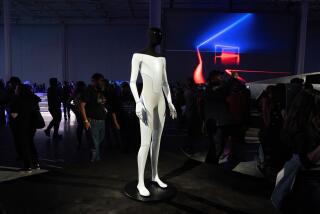Power Companies Recruit Only the Toughest Robots
- Share via
ATLANTA — The nation’s utilities are looking for a few good robots, preferably those with some military background and the guts for dangerous assignments.
The power industry is increasingly taking robotics developed by the military and aerospace industry and adapting them for use on power lines, water tunnels and drilling platforms. Some day, utility executives hope, machines, not humans, will perform the industry’s most dangerous tasks.
“But it’s very, very expensive to develop robotics and the only places where it’s really done is the military and the aerospace industry,” said Ken Brittain, who heads an Electric Power Research Institute office in Charlotte, N.C.
“Basically, we keep our eye out for things that look interesting and see if they can be adapted to our use.”
The institute, based in San Jose, Calif., is a research-and-development arm of the power industry and funded by most of the nation’s utilities.
It’s Maintenance Equipment Application division, located in Charlotte, seeks out existing robot technology and determines whether it can be used by the power companies.
The institute’s Tomcat--an acronym for teleoperator for operations, maintenance and construction using advanced technology-- has been successfully tested in several states where it was able to work on live power wires, even in driving rain.
Spokesmen said they hope that the Tomcat will eventually replace the workers who have traditionally mounted power lines in cherry pickers to handle potentially dangerous lines.
“With this, the workers can stay safely in their cabs and operate the robots from there,” Brittain said.
The experimental Tomcat has received high marks from power company workers who have used it.
“Tommy can probably do any live-line maintenance job there is,” said Joseph Van Name, a supervisor at Philadelphia Electric who has operated the device. “We’ve changed insulators, spacers, and installed and removed dampers with it, and performed jobs in rainstorms that could not be done by any maintenance method.”
Robots developed decades ago quickly found a place in factories, where they have remained a seemingly permanent fixture.
“Manufacturing’s (robots) are fixed-place robots that do things repetitively,” Brittain said. “It puts part ‘B’ to part ‘A’ all day long.
“The other type of robots, the new ones we are looking at now, are made for hostile environments, like underwater or outer space. They can move and perform tasks and deal with the unexpected.”
Few industries have the research-and-development budgets to develop such complicated, sophisticated robots.
But the utility’s institute has gotten around the massive cost by seeking out robots developed for other uses and working with manufacturers to adapt them. Usually manufacturers are more than willing to find other uses for their expensive technology.
Researchers at the institute literally dived after robots developed by the military for underwater use.
“We can use robots to perform inspections and retrieve objects,” said Floyd Gelhaus, an institute robotics specialist. “Or they can be used as stable video system platforms, allowing the observation of other equipment in operation.”
The submersible robots have been used by power companies to inspect nuclear facilities and offshore drilling rigs and to clean tanks at electric generating facilities.
Recently, Brittain said, a submersible robot was sent deep into a pipe embedded in a Virginia mountain to inspect a pump. Without the robot, a diver would have had to don pressurized gear and sink thousands of feet down the narrow pipe.
Sensor robots used by the military to detect heat radiation are being tested for use on the nation’s power lines, which are now inspected by workers in helicopters. The new robots can skim across the wires at great speed, recording heat data that could be used to detect leaks or breaks.
“The idea is not to replace power workers, but to put machines in situations that are really too dangerous for people,” Brittain said. “The people can then stand back and operate the machines in safety.”
More to Read
Inside the business of entertainment
The Wide Shot brings you news, analysis and insights on everything from streaming wars to production — and what it all means for the future.
You may occasionally receive promotional content from the Los Angeles Times.










